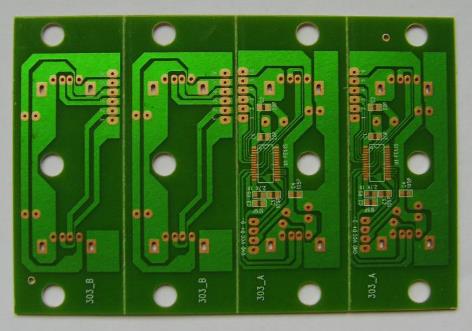PCB multilayer circuit board pressing production process
1. The Autoclave pressure cooker is a container filled with high-temperature saturated water vapor and high pressure can be applied. The laminated substrate (Laminates) sample can be placed in it for a period of time to force moisture into the plate, and then Take out the plate sample and place it on the surface of high-temperature molten tin to measure its "delamination resistance" characteristics. This word is also synonymous with Pressure Cooker, which is commonly used by the industry. In addition, in the PCB multilayer circuit board pressing process, there is a "cabin pressure method" using high temperature and high pressure carbon dioxide, which is also similar to this type of Autoclave Press.
2. Cap Lamination refers to the traditional laminating method of early multi-layer PCB boards. At that time, the "outer layer" of MLB was mostly laminated and laminated with single-sided copper thin substrates until the end of 1984. After the output increased significantly, the current copper-skin type large-scale or large-volume pressing method (Mss Lam) was used. This early MLB pressing method using a single-sided copper thin substrate is called Cap Lamination.
3. Crease wrinkles are often referred to as the wrinkles that occur when the copper skin is improperly handled in the pressing of multilayer boards. Such shortcomings are more likely to occur when thin copper skins below 0.5 oz are laminated in multiple layers.

4. Dent depression refers to the gentle and uniform depression on the copper surface, which may be caused by the local point-like protrusion of the steel plate used for pressing. If there is a neat drop in the faulty edge, it is called Dish Down. If these shortcomings are unfortunately left on the line after copper etching, the impedance of the high-speed transmission signal will be unstable and noise will appear. Therefore, such a defect should be avoided as much as possible on the copper surface of the substrate.
5. When the Caul Plate partition PCB multi-layer circuit board is pressed, a lot of bulk materials (such as 8~10 sets) of the board to be pressed are stacked between each opening of the press (Opening), Each set of "books" must be separated by flat, smooth and hard stainless steel plates. The mirrored stainless steel plates used for this separation are called Caul Plate or Separate Plate. At present, AISI 430 or AISI 630 and so on.
6. Foil Lamination copper foil pressing method refers to mass-produced multilayer boards. The outer layer of copper foil and film is directly pressed with the inner skin to become the large-scale pressing method (Mass Lam) of multiple rows of PCB multilayer circuit boards. Replace the earlier traditional pressing method of single-sided thin substrates.
7. Kraft Paper kraft paper multi-layer board or substrate board is pressed (laminated), and kraft paper is used as a heat transfer buffer. It is placed between the hot plate (Platern) of the laminator and the steel plate to ease the heating curve closest to the bulk material. Between multiple substrates or multilayer boards to be pressed. Try to reduce the temperature difference of each layer of the board as much as possible. Generally, the commonly used specification is 90 to 150 pounds. Because the fiber in the paper has been crushed after high temperature and high pressure, it is no longer tough and difficult to function, so it must be replaced with a new one. This kind of kraft paper is a mixture of pine wood and various strong alkalis. After the volatiles escape and the acid is removed, it is washed and precipitated. After it becomes pulp, it can be pressed again to become rough and cheap paper. material.
8. When the kiss pressure and low pressure multilayer boards are pressed together, when the boards in each opening are placed and positioned, they will start to heat up and be lifted up by the heat of the bottom layer, with a strong hydraulic jack (Ram) upwards Lift, to press the bulk materials in each opening (Opening) to bond. At this time, the combined film (Prepreg) begins to gradually soften or even flow, so the pressure used for the top extrusion can not be too large to avoid slippage of the sheet or excessive outflow of the glue. This lower pressure (15-50 PSI) initially used is called "kiss pressure". However, when the resin in the bulk materials of each film is heated to soften and gel, and is about to harden, it is necessary to increase to the full pressure (300-500 PSI), so that the bulk materials can be tightly combined to form a strong multi-layer board.
9. Lay Up laminated multi-layer circuit boards or substrates need to be aligned, aligned, or nested up and down with various bulk materials such as inner layer boards, films and copper sheets, steel plates, kraft paper pads, etc. before pressing. Work properly so that it can be carefully sent to the pressing machine for hot pressing. This kind of preparatory work is called Lay Up. In order to improve the quality of the multilayer board, not only this kind of "stacking" work must be carried out in a clean room with temperature and humidity control, but also for the speed and quality of mass production, generally those with less than eight layers use the large-scale pressing method (Mass Lam ) In construction, even "automated" overlapping methods are needed to reduce human errors. In order to save workshops and shared equipment, most factories generally combine "stacking" and "folding boards" into a comprehensive processing unit, so the automation engineering is quite complicated.
10. Mass Lamination large-scale pressing board (laminated) This is the PCB multilayer circuit board pressing process to give up the "alignment pin"
PCB factories should pay attention to the production skills of multilayer circuit boards.